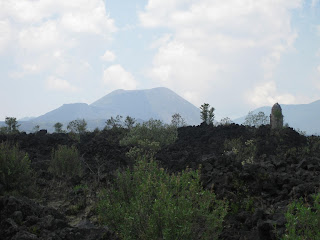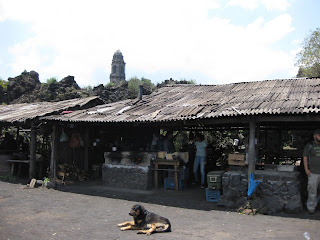This week’s bulletin
is a portrait of another Mexico than the urban bustle of Zamora, and still less
of Guadalajara. The Colegio de Michoacán was founded by a famous Mexican
historian, Luis González y González. Don Luis is particularly famous for a
history of his home town, San José de Gracia, Michoacán. His son, Martín and
his wife Nora, took us to visit San José and the family home.
The drive to San José
rises gently from the valley floor of Zamora, eventually reaching 1,900 metres
above sea level. Here there are no “berries” cultivated under plastic covers,
but a rolling plain of pasture land for cows – lots of cows. San José
(population just under 10,000) was once part of the state of Jalisco, but the
cattle farmers of the town disliked being ruled from nearby Mazamitla. After a
long political tussle, in 1888 they established their own municipality and had
the state boundaries moved so that the new town would be in Michoacán. The plan
of the new settlement was traced by ox-drawn ploughs.
 |
| The González home in San José |
Modern Mexican homes
are flat-roofed structures of concrete and reinforcing steel bars. Many homes
in contemporary San José are of this type, but this was not the architecture of
traditional Mexican homes, as the González household demonstrates. The
construction materials were simple and local: walls of adobe (mud
brick), beams and columns of local and abundant timber, and a roof (with a
large overhang to protect the adobe walls from rain) of ceramic tiles.
No nails were used: sheer weight holds the timbers in place.
The current house
retains three sides of the quadrangle (the fourth was sold at some stage to a
neighbour). In the centre is a partly paved garden of plants (some for herbs)
and trees (some for fruit) and a well for water. At the rear was once a garden
or orchard and room for animals: a cow perhaps, and horses. The family cattle
ranch was a short horse ride from town.
 |
| The González hom in San José |
The González who built
the family home had studied for the priesthood, but changed his mind and
married, intending to have a large family. However, the only child was Luis,
the future historian.
 |
| The González home in San José |
Luis was only a year
old when the Cristero revolt (1926-1929) broke out in western Mexico. When the
Catholic church closed its doors in protest against the federal government’s
policies, fervent Catholics in towns like San José took up arms. The González
family did not join the guerrilla bands, but remained loyal to the Catholic
church. In secret, they converted a room in their home into a chapel, complete
with its retablo (altarpiece) and altar. It also had an escape hatch for
the priest in case the federal troops surprised the family in worship. Eventually,
the federal army advanced across the plains around San Luis. The population
fled and the government troops set up their headquarters in the González’s
home. Since the soldiers were good Catholics they left the chapel untouched.
Over time some
innovations were introduced into the González home: one room was used to
install a baño inglés (English bathroom), complete with a bathtub. In
some rooms the original wooden beams were concealed by a large painted canvas
called a tapacielos (literally sky cover).
An uncle, a local
priest, took the education of Luis in hand and sent him to school in Guadalajara.
From there the young González undertook his university studies and, after
graduating, was sent to Paris to study for a PhD. War interrupted his studies
and Luis returned to Mexico where he served briefly in the Mexican army. This
was not a terribly dangerous occupation: Mexico joined the Allied forces but
sent only a token number of soldiers and one air squadron.
 |
| Statue of Luis González |
Luis longed to return to
San Luis, but his career took him to the Colegio de México, the most
prestigious social sciences centre in Mexico and home to many great Mexican
historians. González was very well connected in Mexican academia and politics
(in Mexico these two worlds are not at all separate). He used his influence to
create in Michoacán an equivalent of the Colegio de México. The brand new
Colegio de Michoacán opened its doors in 1979, initially, in a small house in
the centre of Zamora, sufficiently close to San José for Luis to settle into
the family home at last.
Behind the house,
where once stood the odd cow, the horses, no longer needed in the age of the
motor car, and the orchard, don Luis built a library to house his rather more
than 20,000 books. Jan, ever the librarian, asked if the library was catalogued.
Martín replied that the books are not exactly catalogued, but that they are
organized according to his father’s interests. To wander the library is to walk
through the long and dramatic history of Mexico and the many ways in which it
has been interpreted.
Mexicans learn through
their school textbooks and public celebrations a standard narrative of their
history. The story begins with pride in the great indigenous civilizations and
the Aztec’s heroic fight to the death against the Spanish conquerors. For the next
three hundred years of colonial rule no heroes are identified but the struggle
for Independence created some of the most revered heroes: such as the priests Hidalgo
and Morelos. Resistance to foreign
invasions during the 19th century raised more to the status of
national hero. The Mexican Revolution of 1910-1920 made more worthy of statues
in public spaces across the republic: notably the peasant leader Emiliano
Zapata, or the rampaging general Pancho Villa, notable for being the only
Mexican to invade the United States (actually just the small town of Columbus,
New Mexico and for only a few hours).
 |
| Statue of Apolinar Partida |
From the perspective
of a small town of cattle ranchers like San José de Gracia, the history of the
nation looks quite different. Revolutionary bands were usually bad news – there
were no landless peasants here, nor greedy big landowners. The anti-clerical
revolutionary governments of the 1920s were still worse. In May 1918 the forces of the ferocious Inés Chávez García, more bandit than
revolutionary attacked San José. Apolinar Partida led the defence and died defending his town along with all but one of his
fighters, but not before gunning down between 70 and 100 of their enemies. A statue in the square commemorates his bravery. Another statue records the career of another Partida, Anatolio, "the valiant general who led the San José Division in the Cristero movement 1927-1929. One of his colonels was a certain Honorato González. Anatolio died in 1978 when the Cristero revolt was a distant memory in the nation's capital, but no in San José.
 |
| Statue of Anatolio Partida |
Most Mexican towns
have an obligatory statue of a national hero celebrated in the textbooks. Not
so in San José de Gracia. Here, many are considered malign outside influences.
San José honours those who have defended, or done important things for, the
town. Two bronze statues are devoted to men who defended San José in battle,
complete with rifle and belt of bullets. Two González ancestors flank the
church. One is the grandfather of don Luis who met President Porfirio Díaz to
persuade him to separate the town from Mazamitla’s control. The other is the
uncle and priest who sent young Luis to school in Guadalajara. Luis himself stands
opposite the church.


































